Higher afterload - Study guides, Class notes & Summaries
Looking for the best study guides, study notes and summaries about Higher afterload? On this page you'll find 1160 study documents about Higher afterload.
Page 3 out of 1.160 results
Sort by
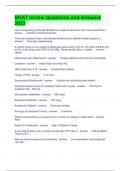
-
BKAT review Questions and Answers 2023
- Exam (elaborations) • 4 pages • 2023
-
Available in package deal
-
- $20.99
- 1x sold
- + learn more
BKAT review Questions and Answers 2023 Upon recognizing ventricular fibrillation in a safe environment, the nurse should then establish unresponsiveness The most important step in preventing central venous catheter related sepsis is: Thorough handwashing. A routine check of your patient's blood gas values show a pH of 7.40, pO2 of 98mm Hg, pCO2 of 38 mmhg, and HCO3 of 25 mEq. These results reflect Normal values Nitropressin and Dobutamine Reduce afterload and improve c...
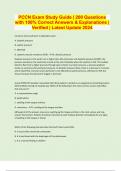
-
PCCN Exam Study Guide | 200 Questions with 100% Correct Answers & Explanations | Verified | Latest Update 2024
- Exam (elaborations) • 71 pages • 2024
- Available in package deal
-
- $15.49
- + learn more
Coronary artery perfusion is dependent upon: A. diastolic pressure B. systolic pressure C. afterload D. systemic vascular resistance (SVR) - A. diastolic pressure Diastolic pressure in the aortic root is higher than left ventricular end-diastolic pressure (LVEDP), the pressure exerted on the ventricular muscle at the end of diastole when the ventricle is full. This enables blood to flow from a higher pressure through open arteries to a lower pressure, a pressure gradient known as coronar...
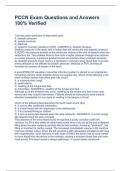
-
PCCN Exam Questions and Answers 100% Verified
- Exam (elaborations) • 56 pages • 2024
-
Available in package deal
-
- $14.99
- + learn more
PCCN Exam Questions and Answers 100% Verified PCCN Exam Questions and Answers 100% Verified PCCN Exam Questions and Answers 100% Verified PCCN Exam Questions and Answers 100% Verified Coronary artery perfusion is dependent upon: A. diastolic pressure B. systolic pressure C. afterload D. systemic vascular resistance (SVR) - ANSWER-A. diastolic pressure Diastolic pressure in the aortic root is higher than left ventricular end-diastolic pressure (LVEDP), the pressure exerted on the...

-
PCCN|| 200 questions|| Correct Answers|| Verified
- Exam (elaborations) • 56 pages • 2024
-
Available in package deal
-
- $13.99
- + learn more
Coronary artery perfusion is dependent upon: A. diastolic pressure B. systolic pressure C. afterload D. systemic vascular resistance (SVR) - ANSWER A. diastolic pressure Diastolic pressure in the aortic root is higher than left ventricular end-diastolic pressure (LVEDP), the pressure exerted on the ventricular muscle at the end of diastole when the ventricle is full. This enables blood to flow from a higher pressure through open arteries to a lower pressure, a pressure gradient known as cor...
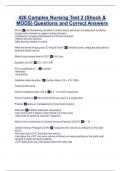
-
426 Complex Nursing Test 2 (Shock & MODS) Questions and Correct Answers
- Exam (elaborations) • 23 pages • 2024
-
Available in package deal
-
- $10.99
- + learn more
Shock Life-threatening condition in which tissue perfusion is inadequate to deliver oxygen and nutrients to support cellular function -Imbalance in supply and demand for O2 and nutrients -Affects all body systems -May develop rapidly or slowly What are three things good CO should have? Effective pump, adequate vasculature, sufficient blood volume What is the normal level of CO? 4-8 L/min Equation for CO: CO = SV x HR SV is composed of...: -preload -afterload -contractility Cardiacs index eq...
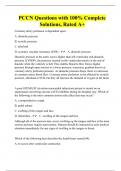
-
PCCN Questions with 100% Complete Solutions, Rated A+
- Exam (elaborations) • 90 pages • 2024
-
Available in package deal
-
- $13.99
- + learn more
Coronary artery perfusion is dependent upon: A. diastolic pressure B. systolic pressure C. afterload D. systemic vascular resistance (SVR) - A. diastolic pressure Diastolic pressure in the aortic root is higher than left ventricular end-diastolic pressure (LVEDP), the pressure exerted on the ventricular muscle at the end of diastole when the ventricle is full. This enables blood to flow from a higher pressure through open arteries to a lower pressure, a pressure gradient known as coronar...
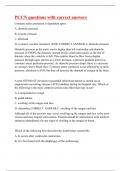
-
PCCN questions with correct answers
- Exam (elaborations) • 90 pages • 2023
- Available in package deal
-
- $14.49
- + learn more
Coronary artery perfusion is dependent upon: A. diastolic pressure B. systolic pressure C. afterload D. systemic vascular resistance (SVR) CORRECT ANSWER A. diastolic pressure Diastolic pressure in the aortic root is higher than left ventricular end-diastolic pressure (LVEDP), the pressure exerted on the ventricular muscle at the end of diastole when the ventricle is full. This enables blood to flow from a higher pressure through open arteries to a lower pressure, a pressure gradient known ...
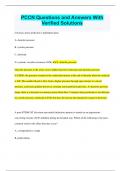
-
PCCN Questions and Answers With Verified Solutions
- Exam (elaborations) • 122 pages • 2024
- Available in package deal
-
- $12.49
- + learn more
PCCN Questions and Answers With Verified Solutions Coronary artery perfusion is dependent upon: A. diastolic pressure B. systolic pressure C. afterload D. systemic vascular resistance (SVR) A. diastolic pressure Diastolic pressure in the aortic root is higher than left ventricular end-diastolic pressure (LVEDP), the pressure exerted on the ventricular muscle at the end of diastole when the ventricle is full. This enables blood to flow from a higher pressure through open arteries t...
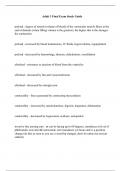
-
Adult 3 Final Exam Study Guide
- Exam (elaborations) • 15 pages • 2023
-
- $8.00
- + learn more
preload - degree of stretch (volume of blood) of the ventricular muscle fibers at the end of diastole (when filling volume is the greatest). the higher this is the stronger the contraction preload - increased by blood transfusions, IV fluids, hypervolemia, regurgitation preload - decreased by hemorrhage, diuresis, dehydration, vasodilation afterload - resistance to ejection of blood from the ventricles afterload - increased by htn and vasoconstriction afterload - decreased by nitroglyceri...
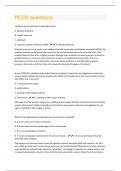
-
PCCN Questions with 100 % correct Answers | Verified
- Exam (elaborations) • 67 pages • 2024
- Available in package deal
-
- $8.89
- + learn more
Coronary artery perfusion is dependent upon: A. diastolic pressure B. systolic pressure C. afterload D. systemic vascular resistance (SVR) - A. diastolic pressure Diastolic pressure in the aortic root is higher than left ventricular end-diastolic pressure (LVEDP), the pressure exerted on the ventricular muscle at the end of diastole when the ventricle is full. This enables blood to flow from a higher pressure through open arteries to a lower pressure, a pressure gradient known as coronar...

Did you know that on average a seller on Stuvia earns $82 per month selling study resources? Hmm, hint, hint. Discover all about earning on Stuvia


